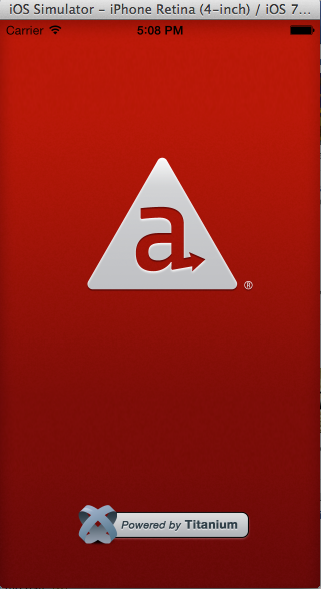On the last
part of the tutorial we created Views using the Alloy markup. Now we will try to create a View using the hard way and you have to decide which way do you prefer. Using the xml or using the .js file ?
1) Open MyFirstProject/app/controller/index.js delete all the codes. Run the app and you will see something like this:

*stuck in the splash screen?
Of Course because we deleted “$.index.open();” which opens the Alloy markup or the index.xml. Because of that we must create it programmatically.
2) Open index.js and write this code.
var container = Ti.UI.createWindow({
backgroundColor: ‘white’
});
container.open();
Now if you run your app, did it display a white screen? how did that work?
we just simply convert:

3) Let’s create the 3 Views:
var container = Ti.UI.createWindow({
backgroundColor: ‘white’,
layout: ‘vertical’
});
var container = Ti.UI.createWindow({
backgroundColor: ‘white’,
layout: ‘vertical’
});
var view_image = Ti.UI.createView({
top: ’10%’,
width: ’100%’,
height: ’35%’,
backgroundColor: ‘#4B0082
‘});
var view_welcomeMessage = Ti.UI.createView({
width: ’100%’,
height: ’10%’
});
var view_buttons = Ti.UI.createView({
layout:”vertical”,
top: “3%”,
height: ’50%’
});
container.add(view_image);
container.add(view_welcomeMessage);
container.add(view_buttons);
container.open();
First we created the three views then we add it on the container and then open the container. As you notice here:

It’s almost the same, It’s just that we are not using index.tss to customize our Views, we just insert the properties inside the parameter or “ myView({ property:’value’ ’’}); ”.
4) Let’s create an ImageView then add it to the view_image:
//creating imageview
var img_logo = Ti.UI.createImageView({
width: ’100%’,
height: ’100%’,
image:’/image/f_logo.png’
});
//adding the imageView to the view_image
view_image.add(img_logo);
5) Let’s create a Label and add it to the view_welcomeMessage:
//label
var lbl_welcomeMessage = Ti.UI.createLabel({
text:’Welcome to my first cross platform app using Appcelerator Titanium’,
textAlign: “center”,
font:{ fontFamily:’Georgia-Italic’ }
});
//add to the view_welcomeMessage
view_welcomeMessage.add(lbl_welcomeMessage);
6) Let’s create Buttons and add it to the view_buttons:
//creating buttons
var btn_lFacebook = Ti.UI.createButton({
height:”18%”,
backgroundColor: “#87CEFA”,
width: “60%”,
title: ‘Log in with Facebook’
});
var btn_lGmail = Ti.UI.createButton({
top: “4%”,
height:”18%”,
backgroundColor: “red”,
width: “60%”,
color: “white”,
title: ‘Log in with Gmail’
});
var btn_createAccount = Ti.UI.createButton({
top: “4%”,
height:”18%”,
backgroundColor: “#F0F8FF”,
width: “60%”,
title: ‘Create an account’
});
//adding it to the view_buttons
view_buttons.add(btn_lFacebook);
view_buttons.add(btn_lGmail);
view_buttons.add(btn_createAccount);
run the project and you will see something like this:

Conclusion: Creating Views using xml is a lot easier than creating it dynamically or programmatically. But sometimes creating Views dynamically gives us an advantage especially when displaying a complex data. For example if you will retrieve a lot of data and display it on a TableView row, it is a lot easier creating it dynamically with the use of a loop,in that case your row will be created repeatedly rather than creating it using xml one by one.
Stay tuned for our next tutorial.